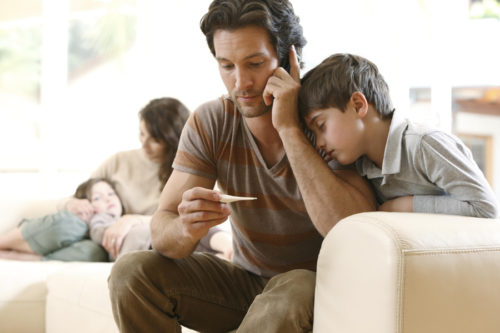Why So Many Illnesses In My Child
I spend a lot of time writing about and explaining illness; while assuming you know about “bugs” and “viruses” and “Immunity” and “baby shots” . Kids get sick, get better, get sick, get better and get sick again. How much is too much?
How many is TOO many childhood illnesses
And sometimes something even prevents them from getting better in one “cycle” of our “expected” length of illness (usually about 10 days). It can seem like they get one “bug” right after another and are always sick; and sometime they really are.
Lets take a breath, step back and take a look at the wide-range view of the “sickness” thing with the intent of understanding not just “why this illness” but “why so many illnesses?” Not just “why are they sick NOW” but “why are they sick so much?”
Childhood Illnesses
How Many Illnesses Is Too Many
We are NOT talking about chronic illnesses they are born with or have developed along the way. We ARE talking only about self-limited illnesses they contract in episodes and can resolve – eventually.
We’ll begin by listing the basics that we DO know – in the “broad” and “general” sense.
- Several things are called “bugs” by people and cause the diseases we are talking about – you know, bacteria, viruses, yeasts etc.
- The body has defenses of its own to fight infections of all kinds and possibly to prevent some types from happening again (called immunity).
- Each “bug” type has its own way of being “transmitted,” “attacking” and “spreading” to its next “victim.”
- Some “bugs” attack, multiply and can “spread” BEFORE they cause observable symptoms.
- “Bacteria-bugs” are living things so can be killed by antibiotics. “Virus-bugs” are NOT living and only “take-over” a human cell so antibiotics can’t kill them.
- Organs like the nose and throat get “sick” the same way whether it’s a “bacteria-bug” or “virus-bug” attacking them, so it’s hard to tell which is which.
- There are some things that make it easier for “bugs” to get going – like malnutrition, stress, other chronic illnesses etc.; and some things that make it harder for them – like good nutrition, exercise, hygiene and immunity.
So, standing back at a distance and looking at all kids in general, let’s say over a couple years, what things are YOU noticing about kids illnesses over time. Do YOU notice any patterns from your own experience.
Patterns Of Illnesses

Well YES! That’s a good one! I’m glad you see it: More illnesses in the WINTER. But that’s only because you are only looking at northern kids. Look at all those south of equator. What do you see? Yes, it’s reversed. Why is that do you suppose?
It’s not so much the weather but what the weather produces: More exposure to people inside! And, the more people you are in close proximity to during the day, the more chances that one of them may be sick and give you their “bug!” It’s the exposure to “bugs” remember which causes the illness, not the weather.
Do you notice, from your broad view of children, any other “patterns” of illness? Let me list three “high-density” times when children get sick a lot: the second “year,” the second “child” and entering “daycare” or “school.”
The Second Year
Intuitively you already know that your baby is “immune” to most diseases its mother has already had herself during her own lifetime – right up until that umbilical chord was cut. Those “antibodies” float around in the baby for several months (9 – 12 or so) and give them a temporary break from those illnesses – or make them a very weakened form of illness.
For example there’s a case where the baby is exposed to Chicken Pox or Measles which the mother has already built up immunity to back when she had the disease. Then, either the baby’s passive antibodies are so strong that he/she doesn’t get the disease OR the disease he/she does get is so mild that the symptoms are barely present and unrecognizable. In the latter case they would have antibodies in their blood but swear they had never had the disease.
In the baby’s second year, the passive immunity is gone so the second year is when illnesses begin in earnest. The “normal” child contracts eight to ten “bugs” every year – that’s about one a month!
BUT, with each illness the body begins to develop its own satchel full of antibodies it can use to ward off future attacks! The problem is that there are a whole lot of “attackers.” Once they begin filling the satchel though, the number of illnesses will drop. I promise!
The Second Child

Unfortunately, for most children, that drop in the number of illnesses is very short lived once older brother or sister gets ambulatory enough to venture out into the outside world on short excursions – and bring back the “bugs” they find out there.
That’s right, even though the younger child may be a “home-body,” that doesn’t protect them much when their older siblings want to share the results of their adventures out among the populace.
Each subsequent child gets sick more often and earlier simply due to statistics; namely, more exposure → more illness. “Why is Crystal more sick than her brother Duke?” The answer, “She has an older brother.”
Daycare (and School)
Another “bump” in the number of illnesses a child gets is at the time (like it or not) they go to daycare or school; and for pretty much the same reason as listed above: statistics.
I guess the most ideal situation is to find a trusted sitter who comes to your house each day and takes care of only your child – perhaps a grandmother comes to mind. After all, you and your husband turned out alright… didn’t you?
And, if you could find one who never gets sick, has any other commitments, never travels, volunteers to work just for the lunch because she enjoys it so much and… dare we hope… has a British accent as well. Well, that would just about be perfect.
Short of that, going to another stay-at-home mother’s home with limited other children would be the next-best, illness-limiting experience for your child.
And that being unavailable, there’s daycare. Much improved from unregulated days gone by, they still are, I’m sorry to say, gathering places for “bugs.” The centers don’t surprise you with last minute unavailabilities like a single person would; but, the “rules” imposed are sometimes frustrating. For example, you can’t bring your sick child to the center who gave him the illness in the first place.
And unbelievably, some even won’t let you return with your child without a written “attestment” from the doctor that he/she’s well and not contagious! (as if we had crystal balls).
We physicians have “Medline,” a sort of “Google” for medicine, which lists almost every stitch of research done in every field – and, as it turns out, no matter how stupid.
For example, one research study correlated the use of “the common cloth technique” (one rag being used to wipe all children’s runny noses!) versus using individual wipes with the number of respiratory infections in the children of the center.

I didn’t get the date on the study but hope to high heaven that it was back in the days before they discovered hand-washing before/between surgical procedures prevented infections! Otherwise, that’s just bizarre. None-the-less the authors concluded with considerable gravity that the “practice should be discouraged.” Ya think?!
A slightly more recent and applicable study compared children reared at home versus daycare with their attendance in kindergarten and first grade. It was no surprise that those from daycare environments MISSED LESS SCHOOL than those kept at home. They had already been sick with those diseases.
And finally, my own example of being nearly continuously sick with a “cold” of some sort during my entire pediatric residency – except for rotations in the nursery – to the point that I was beginning to believe I had made an impossible career choice; only to find later that my early practice years were nearly disease free.
Immunity is a great thing, once you have it!
So, Now What?
For many of you, especially those going through those tough spells, this next advice may seem a bit tough to swallow; but, when looking at the whole of children’s illnesses it’s best to be fairly philosophical.
Consider that: “sooner or later children are going to catch pretty much everything there is out there to catch” and if they do it’s better to “have it and get it over with” while you are there to look after them instead of some who-knows-what roommate in a dorm-room.
Focus on the battles in your control by: giving them the passive immunity from the terribly destructive diseases for former years – immunizations; instilling in them disease-reducing life habits – hygiene, nutrition and exercise; and, when needed, seek the experience and advice of a trusted physician.
Try to keep focused on the bigger picture and realize that even when going through a really rough patch of illnesses, your child is basically healthy. Even looking at the established routine for “well child care” you’ll see that it’s designed with emphasis on those three “rough patches” – second year, second child and daycare/school.
To quote a colleague: “A stronger immune system, fewer allergies, improved school attendance, and better long-term health can come from not having your child living in a plastic bubble.”
Call, if you need to talk.

